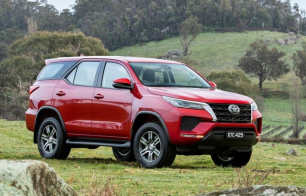This is a Raptor review so you might expect I’d be justified in spending the entire test doing donuts in the sand and taking on jumps that would make dirt-bikers wince, but as much as I wanted to, I didn’t. I live in the real world so my tests are about how a vehicle performs in day-to-day driving and especially off-roading.
But to reach the dirt you have to drive a bit of blacktop – so how does the Raptor perform on-road?
Once underway, there is plenty of good news about the Raptor because it is nice to drive on road: a composed stance, impressive acceleration with more get-up-and-go thrust under foot courtesy of the V6 and comfortable ride and handling. This is an easy-driving 4WD ute.
For a vehicle intended to be a great go-fast machine on dirt roads and gravel tracks – which, of course, it is – the Raptor is a pleasant surprise on bitumen – refined and comfortable with its off-road-suited long-travel Fox suspension that soaks up the worst lumps and bumps of back-road blacktop, yielding a smoothed-out plush ride.
As a bonus the steering has a sharp feel and a nice balanced weight to it – you can cycle through different modes ('Normal', 'Comfort', 'Sport', 'Off-Road') to find your favourite – and the gutsy V6 and clever transmission is a supremely relaxed pairing.
There are also selectable damper modes ('Normal', 'Off-Road', 'Sport') and exhaust modes ('Quiet', 'Normal', 'Sport', 'Baja'). The latter exhaust setting is only available when in off-road mode and is more of a novelty, but still fun to play around with and a cool addition to the Raptor package.
On the open highway at 110km/h, the Raptor sits nicely, with that wider wheel track giving this ute a settled posture, and it comfortably trucks along the road, no matter how bumpy that road becomes.
Then you take it off the sealed surface.
The Raptor has all the mechanicals and the tech set-up for driving dirt roads and gravel tracks at speed, there’s no denying that, but all of those factors don't necessarily make it a good 4WD or indeed a good 4WD touring vehicle.
However, it is.
It’s smooth and refined on fast dirt tracks and gravel roads – it’s right at home. The Raptor has that aforementioned wide wheel track and, even if the terrain is particularly severe, it drives comfortably.
And any doubts about its ability to tackle low-range 4WDing are swiftly dispelled.
I scaled several of our favourite set-piece hill-climbs without the front or rear diffs locked, and the Raptor did it with absolute control and absolute ease.
It's very capable and ticks all the boxes in terms of ground clearance (listed as 272mm), off-road angles (approach: 32 degrees, departure 24 (with towbar, 27 without) and rampover 24 degrees) and wading depth (850mm).
There’s ample torque available and it’s delivered in an even-handed manner; the Raptor has front and rear diff locks; and the driver-assist tech set-up is comprehensive and low-key effective.
Case in point, I used 'Trail Control' mode (a form of low-range ‘feet-off-the-pedals’ cruise control) to set the speed (2.0km/h) for a steep hill and it kept the Raptor to that speed – complete control at all times, no matter how the severity of the incline changed.
The Raptor also has an onboard 360-degree camera system, giving the driver the ability to see forward of the vehicle, which is handy because this ute has a substantial bonnet. You can't see the track in front of you over the bonnet, especially when climbing a steep hill.
It’s such a great combination of mechanicals and driver-assist tech and Fox shocks, long wheel travel and proper all-terrain tires (BFGoodrich K02s) that it’s a near-complete package, especially in terms of being an effective off-road vehicle.
But if you’re considering a Raptor as a touring vehicle, there are some things working against it – and those things have to do with weight.
Payload in the Raptor, at just over 717kg, is not spectacular, but it’s in line with a lot of modern dual-cab utes. However, it’s far from ideal if you're looking at putting aftermarket equipment on it or even loading up with camping gear.
And another thing is the Raptor doesn't have an industry standard braked towing capacity for a dual-cab ute: it can legally tow 2500kg – the industry standard for similarly sized utes is 3500kg. Unbraked towing capacity is 750kg.
And though the driver-assist tech onboard is comprehensive and effective, the Raptor misses out on a tow/haul drive mode.
For your reference, kerb weight is listed as 2473kg, GVM is 3130kg, and GCM is 5370kg.
If you’re looking specifically for a tow vehicle, then look elsewhere, but if you're looking for thrills and fun in a capable off-road vehicle, the Raptor should be at the top of your list.






